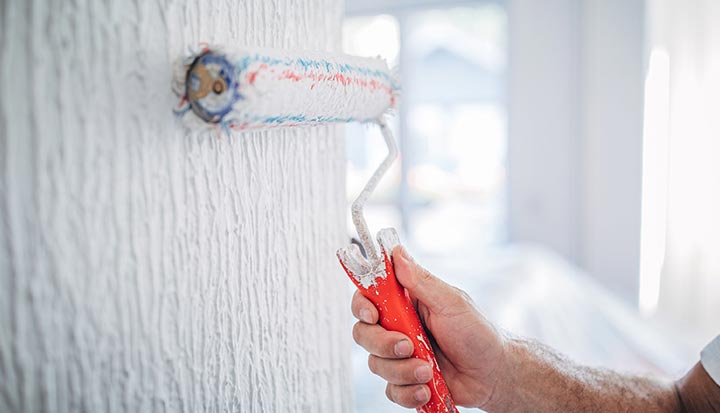
Although painting may appear simple, a lot of things could simply go horribly wrong sometimes, and you need to rectify them immediately.
No matter how cautious or skilled you are with paint, bad paint jobs might occasionally occur while painting a wall or ceiling. There are numerous real-life stumbling blocks that can appear and hinder a flawless paint application, including how easily paint can splatter, drip, and spill.
How do I fix a bad paint job?
A poor paint job isn’t irreparable. Fortunately, if you know what to do about a bad paint job and take the right action at the right time, practically anything paint-related can be fixed. Most errors can be corrected without too much difficulty. Try one of these simple solutions the next time you make a mess or a mistake that can ruin an otherwise perfect project.
Even Out Uneven Paint
Your walls may end up looking spotty and unevenly painted. By initially allowing the paint to dry, you can correct uneven painting. Apply a second layer after that. Continue doing this until you get the desired outcome. Ensure that the roller’s edge is always wet.
Using an 18-inch roller makes painting walls less difficult because you can paint a bigger area faster. The professional-looking finish will be worth the higher price, though.
Eliminate Brush and Roller Marks
When a brush or roller edge doesn’t stay wet when painting, brush and roller markings typically result. Here’s how to correct this wall painting error:
- Sand the rough spots until they are smooth. After that, patching could be required. Be mindful, though, as it might remove underlying paint. It could be simpler to patch up the entire region.
- Clean the walls.
- Prime
- Paint
To avoid lines with thicker edges, be sure to roll the paint out of the roller’s sides.
Remove Drips of Dried Paint
Overloading brushes and rollers is the main cause of dried paint drips.
To correct this painting error, use a paint scraper to remove the drips or sand the area smooth. Next, wipe the area with a moist cloth and repaint it. To get rid of dry paint drips, you’ll need to use a razor blade.
By always having a cloth on hand to wipe up any new spills or drips, you can avoid making this painting error. Drop cloths are also excellent at eliminating this.
Paint On the Trim
It’s not always necessary to paint the trim in addition to the walls. When paint unintentionally gets on your trim, use these steps to fix it:
- Sand
- Clean
- Apply touch-up trim paint.
Banish Bubbles on Your Walls
This painting error is typically caused by some form of moisture or heat issue. Here are the remedial steps:
- Locate and address the root issue.
- Scrape bubbles away
- Sand the area.
- Clean
- Prime
- Repaint
Cover up Wall Patches
By using a small roller for applying primer, you can cover up wall patches. Apply paint after it has dried.
More than one coat might be necessary. This may aid in matching the texture and thickness of the surrounding paint.
Smoothen Wrinkled Paint
When paint is applied too thickly, there isn’t enough time between coats to cure, or if the painting was done in extremely hot or cold conditions, paint wrinkles develop. Sand the area down, clean it, prime it, then repaint it to correct this.
Remove Any Ceiling Spots
If you notice any wet paint on your ceiling, just wipe it off with a brush and clear window cleaner. Use window cleaner carefully as it can remove more paint than you intend. Dry patches will require touching up with a little brush.
Remove Paint from Windows
Wiping it could spread it out and make it more difficult to get rid of.
Using a razor blade to gently scrape off the paint at an angle is the easiest technique to correct this painting blunder. By doing this, you can avoid scratching the glass. Before using the razor blade each time, clean it.
Remove Paint Tape Lines
If the tape is left on the wall for an hour or longer, paint may occasionally come off with it. If you haven’t yet removed the tape:
- Use a razor blade to remove the tape and any raised paint.
- Smooth the area with a sanding block.
- Clean
- Prime
- Paint
Hire a Professional Painting Contractor
There is a sensible answer to the question, “how do I fix a paint job gone bad?” To avoid botched paint jobs that require time-consuming fixes, the best advice is to call in the experts right from the start. The reasons to hire a professional painter include:
- They are insured and licensed to do the job.
- They provide quality work.
- They produce results that are near to perfection.
- They are experienced, efficient, and have perfected their techniques.
- They have all the right materials and equipment.
Contact us
With a complete repaint, let the experts at Tall Guy Painting perform their magic on the outside or interior of your house. To schedule a free on-site inspection and estimate in the Lower Mainland, give us a call right away at (778) 683-5397.